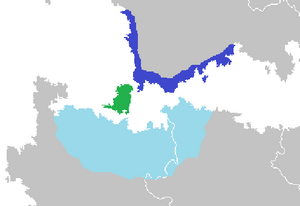Zeliat
The Zeliat were a Bronze Age civilization that inhabited the island of Chryse during the 2nd Millennia BCE.
The origin of the Zeliat are unclear, but it is believed they were the indigenous inhabitants of Chryse. Humans likely settled Chryse sometime in the 4th or 3rd Millennia BCE. Archeological evidence supports continued habitation starting around 2,800 BCE, with the first major settlements following a few centuries afterwards. By 1,800 BCE the Zeliat were well established on the island, forming several major urban areas including the capital of Kust. The Zeliat spoke a language that remained undeciphered and is not considered part of the Erani-Eracuran family. What surviving artifacts of Zeliat culture remain point to a very ritualistic society where the "priest-caste" played a prominent role in politics and everyday life. At their peak the Zeliat numbered around 15,000-25,000 citizens clumped together in seven major settlements, with Kust located on the western coast towards the Sanguine Sea.
The Zeliat were active traders and sailors and records of their travels and goods can be found in locations across northern Syara and Ruvelka. They held close ties with the Gruri to their north, but information regarding the nature of their relationship is unknown. Ties between the Zeliat and the Aleitians of Syara increased during the Bronze Age, with widespread proliferation of Aleitian goods found in archeological sites dating to the mid-2nd Millennia BCE. It its likely the Zeliat traded throughout the Sanguine and Sundering Seas but establishing direct links between artifacts and the Zeliat have often proven difficult, to in part to cross-cultural exchange between the Zeliat and their neighbors which makes identifying points of origin for artifacts difficult. The Zeliat were recognized as a wealthy people by their contemporaries; the name for the island of Chryse (golden), given by the Aleitians, was chosen for the abundance of gold owned by the Zeliat.
Zeliat civilization came to an abrupt end in the late 2nd Millennia BCE, sometime between 1,250-1,100 BCE. Trigged by the Bronze Age Collapse in Siduri, a large force of Aleitians invaded the island and sacked the capital of Kust along with other major cities, none of which were ever resettled. Virtually overnight Zeliat society collapsed, leading to widespread loss of literacy and collective knowledge. Beginning in the 7th Century BCE, colonists from the Kydonian League began settling the island. Coupled with later occupation by Ancient Makedon and the Makedonian Empire the remaining Zeliat population was effectively Hellenized, erasing any remnants of their language and society.
Little is known for certain about the Zeliat; the origin of the term Zeliat itself is unclear. Ancient Syaran linguist Rhadamanthos visited the island in the 7th Century and documented his interactions with the remnants of Zeliat society, which provides the bulwark of collective knowledge on their civilization. Perhaps most significantly, Rhadamanthos dismissed suggestions of a connection between the Zeliat and the Segelen, the native inhabitants of Syara, citing lack of linguistical overlap. Which some Syaran historians have disputed this dismissal, modern research has generally reaffirmed Rhadamanthos's observations.
